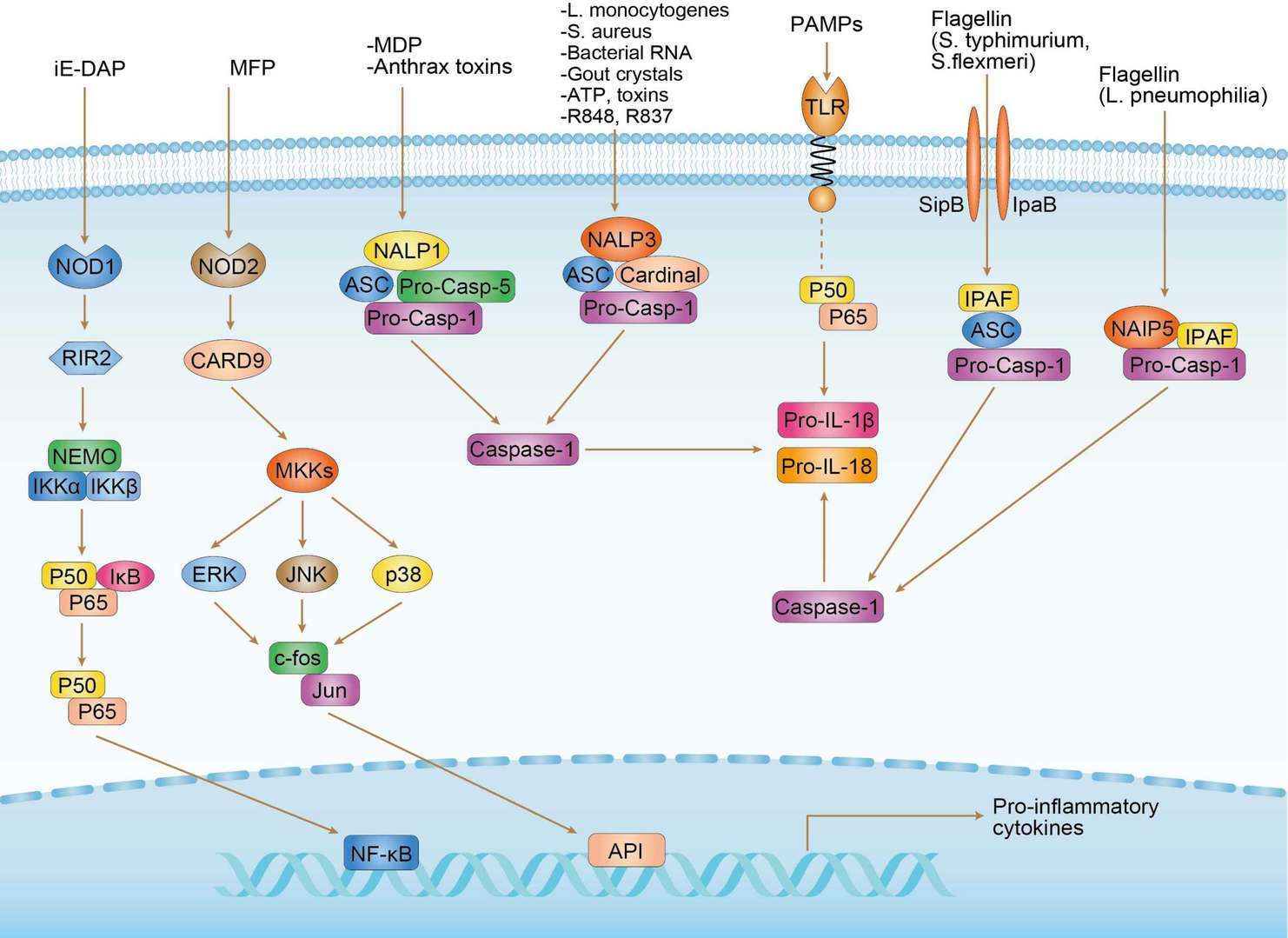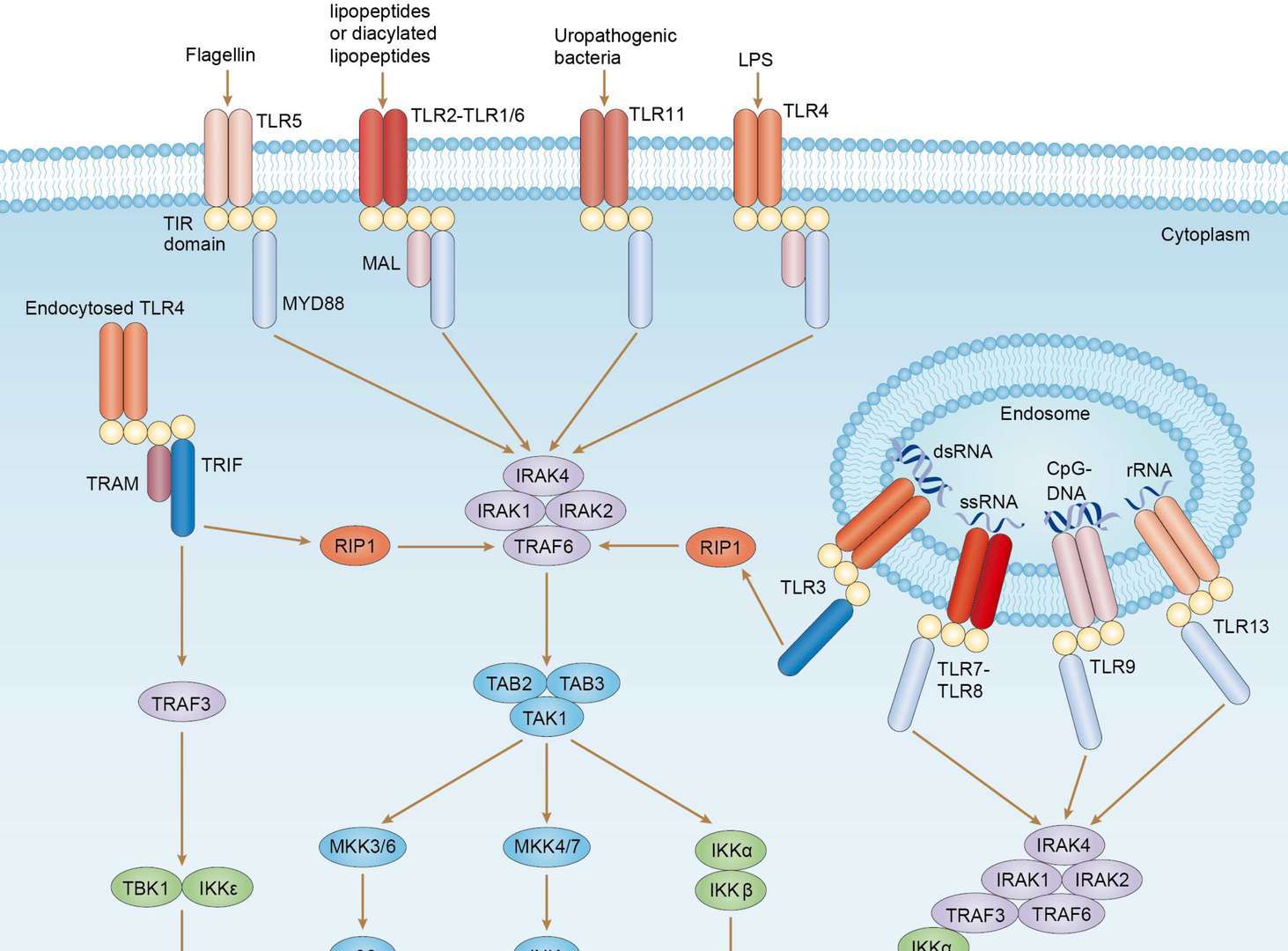 Loading...
Loading...

TLR3
 Loading...
Loading...Anti-TLR3 Products
-
- Derivation: Mouse
- Species Reactivity: Human
- Type: Mouse IgG1
- Application: WB, ICC, IF, IHC, IP, FuncS
- Human Anti-TLR3 Recombinant Antibody (TAB-612CL) (TAB-612CL)
-
- Derivation: Humanized
- Species Reactivity: Human
- Type: Human IgG
- Application: ELISA
-
- Derivation: Humanized
- Species Reactivity: Human
- Type: ADCC enhanced antibody
- Rabbit Anti-TLR3 Antibody (MOB-0272MC)
-
- Species Reactivity: Human, Mouse, Rat, Avian, Bovine, Chicken, Opossum, Primate
- Application: WB, FACS, IHC-P
-
- Derivation: Mouse
- Species Reactivity: Human
- Type: Mouse IgG2b
- Application: WB
- Mouse Anti-TLR3 Recombinant Antibody (clone TLR3.7) (NEUT-2035CQ)
-
- Species Reactivity: Human
- Type: Mouse IgG1, κ
- Application: FC, FuncS, Neut
- Mouse Anti-TLR3 Recombinant Antibody (HPAB-1036WJ) (HPAB-1036WJ)
-
- Species Reactivity: Human
- Type: Mouse IgG
- Application: ELISA, FC
- Mouse Anti-TLR3 Recombinant Antibody (HPAB-1037WJ) (HPAB-1037WJ)
-
- Species Reactivity: Human
- Type: Mouse IgG
- Application: ELISA, FC
- Mouse Anti-TLR3 Recombinant Antibody (HPAB-1038WJ) (HPAB-1038WJ)
-
- Species Reactivity: Human
- Type: Mouse IgG
- Application: ELISA, FC
- Mouse Anti-TLR3 Recombinant Antibody (HPAB-1034WJ) (HPAB-1034WJ)
-
- Species Reactivity: Human
- Type: Mouse IgG
- Application: ELISA, FC
- Mouse Anti-TLR3 Recombinant Antibody (HPAB-1035WJ) (HPAB-1035WJ)
-
- Species Reactivity: Human
- Type: Mouse IgG
- Application: ELISA, FC
- Human Anti-TLR3 Recombinant Antibody (HPAB-0725-CN) (HPAB-0725-CN)
-
- Species Reactivity: Human, Cynomolgus
- Type: Human IgG4
- Application: ELISA, FC
-
- Species Reactivity: Human
- Application: FC, WB
- Human Anti-TLR3 Recombinant Antibody; scFv Fragment (HPAB-0725-CN-S(P)) (HPAB-0725-CN-S(P))
-
- Species Reactivity: Human, Cynomolgus
- Type: Human scFv
- Application: ELISA, FC
- Human Anti-TLR3 Recombinant Antibody; Fab Fragment (HPAB-0725-CN-F(E)) (HPAB-0725-CN-F(E))
-
- Species Reactivity: Human, Cynomolgus
- Type: Human Fab
- Application: ELISA, FC
- Mouse Anti-TLR3 Recombinant Antibody; Fab Fragment (HPAB-1038WJ-F(E)) (HPAB-1038WJ-F(E))
-
- Species Reactivity: Human
- Type: Mouse Fab
- Application: ELISA, FC
- Rat Anti-TLR3 Recombinant Antibody; Fab Fragment (TAB-272CQ-F(E)) (TAB-272CQ-F(E))
-
- Species Reactivity: Mouse
- Type: Rat Fab
- Application: ELISA, FC, IHC
- Mouse Anti-TLR3 Recombinant Antibody; Fab Fragment (TAB-273CQ-F(E)) (TAB-273CQ-F(E))
-
- Species Reactivity: Mouse
- Type: Mouse Fab
- Application: ELISA, FC, IHC
- Mouse Anti-TLR3 Recombinant Antibody; Fab Fragment (TAB-274CQ-F(E)) (TAB-274CQ-F(E))
-
- Species Reactivity: Human
- Type: Mouse Fab
- Application: ELISA, FC
- Mouse Anti-TLR3 Recombinant Antibody; scFv Fragment (HPAB-1034WJ-S(P)) (HPAB-1034WJ-S(P))
-
- Species Reactivity: Human
- Type: Mouse scFv
- Application: ELISA, FC
- Mouse Anti-TLR3 Recombinant Antibody; scFv Fragment (HPAB-1035WJ-S(P)) (HPAB-1035WJ-S(P))
-
- Species Reactivity: Human
- Type: Mouse scFv
- Application: ELISA, FC
- Mouse Anti-TLR3 Recombinant Antibody; scFv Fragment (HPAB-1036WJ-S(P)) (HPAB-1036WJ-S(P))
-
- Species Reactivity: Human
- Type: Mouse scFv
- Application: ELISA, FC
- Mouse Anti-TLR3 Recombinant Antibody; Fab Fragment (TAB-689CT-F(E)) (TAB-689CT-F(E))
-
- Derivation: Mouse hybridoma cell line
- Species Reactivity: Human
- Type: Mouse Fab
- Application: ELISA, FC, Inhib
- Mouse Anti-TLR3 Recombinant Antibody; Fab Fragment (TAB-690CT-F(E)) (TAB-690CT-F(E))
-
- Derivation: Mouse hybridoma cell line
- Species Reactivity: Human
- Type: Mouse Fab
- Application: ELISA, FC, Inhib
- Mouse Anti-TLR3 Recombinant Antibody; Fab Fragment (TAB-691CT-F(E)) (TAB-691CT-F(E))
-
- Derivation: Mouse hybridoma cell line
- Species Reactivity: Human
- Type: Mouse Fab
- Application: ELISA, FC, Inhib
- Rat Anti-TLR3 Recombinant Antibody; scFv Fragment (TAB-272CQ-S(P)) (TAB-272CQ-S(P))
-
- Species Reactivity: Mouse
- Type: Rat scFv
- Application: ELISA, FC, IHC
- Mouse Anti-TLR3 Recombinant Antibody; scFv Fragment (TAB-273CQ-S(P)) (TAB-273CQ-S(P))
-
- Species Reactivity: Mouse
- Type: Mouse scFv
- Application: ELISA, FC, IHC
- Mouse Anti-TLR3 Recombinant Antibody; scFv Fragment (TAB-274CQ-S(P)) (TAB-274CQ-S(P))
-
- Species Reactivity: Human
- Type: Mouse scFv
- Application: ELISA, FC
- Mouse Anti-TLR3 Recombinant Antibody; scFv Fragment (TAB-688CT-S(P)) (TAB-688CT-S(P))
-
- Derivation: Mouse hybridoma cell line
- Species Reactivity: Human
- Type: Mouse scFv
- Application: ELISA, FC, Inhib
- Mouse Anti-TLR3 Recombinant Antibody; scFv Fragment (TAB-689CT-S(P)) (TAB-689CT-S(P))
-
- Derivation: Mouse hybridoma cell line
- Species Reactivity: Human
- Type: Mouse scFv
- Application: ELISA, FC, Inhib
- Mouse Anti-TLR3 Recombinant Antibody; scFv Fragment (TAB-690CT-S(P)) (TAB-690CT-S(P))
-
- Derivation: Mouse hybridoma cell line
- Species Reactivity: Human
- Type: Mouse scFv
- Application: ELISA, FC, Inhib
- Mouse Anti-TLR3 Recombinant Antibody; scFv Fragment (TAB-691CT-S(P)) (TAB-691CT-S(P))
-
- Derivation: Mouse hybridoma cell line
- Species Reactivity: Human
- Type: Mouse scFv
- Application: ELISA, FC, Inhib
- Mouse Anti-TLR3 Recombinant Antibody; Fab Fragment (TAB-687CT-F(E)) (TAB-687CT-F(E))
-
- Derivation: Mouse hybridoma cell line
- Species Reactivity: Human
- Type: Mouse Fab
- Application: ELISA, FC, Inhib
- Mouse Anti-TLR3 Recombinant Antibody; Fab Fragment (TAB-688CT-F(E)) (TAB-688CT-F(E))
-
- Derivation: Mouse hybridoma cell line
- Species Reactivity: Human
- Type: Mouse Fab
- Application: ELISA, FC, Inhib
- Mouse Anti-TLR3 Recombinant Antibody (TAB-687CT) (TAB-687CT)
-
- Derivation: Mouse hybridoma cell line
- Species Reactivity: Human
- Type: Mouse IgG
- Application: ELISA, FC, Inhib
- Mouse Anti-TLR3 Recombinant Antibody (TAB-688CT) (TAB-688CT)
-
- Derivation: Mouse hybridoma cell line
- Species Reactivity: Human
- Type: Mouse IgG
- Application: ELISA, FC, Inhib
- Mouse Anti-TLR3 Recombinant Antibody (TAB-689CT) (TAB-689CT)
-
- Derivation: Mouse hybridoma cell line
- Species Reactivity: Human
- Type: Mouse IgG
- Application: ELISA, FC, Inhib
- Mouse Anti-TLR3 Recombinant Antibody (TAB-690CT) (TAB-690CT)
-
- Derivation: Mouse hybridoma cell line
- Species Reactivity: Human
- Type: Mouse IgG
- Application: ELISA, FC, Inhib
- Mouse Anti-TLR3 Recombinant Antibody (TAB-691CT) (TAB-691CT)
-
- Derivation: Mouse hybridoma cell line
- Species Reactivity: Human
- Type: Mouse IgG
- Application: ELISA, FC, Inhib
- Mouse Anti-TLR3 Recombinant Antibody; scFv Fragment (TAB-687CT-S(P)) (TAB-687CT-S(P))
-
- Derivation: Mouse hybridoma cell line
- Species Reactivity: Human
- Type: Mouse scFv
- Application: ELISA, FC, Inhib
- Mouse Anti-TLR3 Recombinant Antibody; scFv Fragment (HPAB-1037WJ-S(P)) (HPAB-1037WJ-S(P))
-
- Species Reactivity: Human
- Type: Mouse scFv
- Application: ELISA, FC
- Mouse Anti-TLR3 Recombinant Antibody; scFv Fragment (HPAB-1038WJ-S(P)) (HPAB-1038WJ-S(P))
-
- Species Reactivity: Human
- Type: Mouse scFv
- Application: ELISA, FC
- Mouse Anti-TLR3 Recombinant Antibody; Fab Fragment (HPAB-1034WJ-F(E)) (HPAB-1034WJ-F(E))
-
- Species Reactivity: Human
- Type: Mouse Fab
- Application: ELISA, FC
- Mouse Anti-TLR3 Recombinant Antibody; Fab Fragment (HPAB-1035WJ-F(E)) (HPAB-1035WJ-F(E))
-
- Species Reactivity: Human
- Type: Mouse Fab
- Application: ELISA, FC
- Mouse Anti-TLR3 Recombinant Antibody; Fab Fragment (HPAB-1036WJ-F(E)) (HPAB-1036WJ-F(E))
-
- Species Reactivity: Human
- Type: Mouse Fab
- Application: ELISA, FC
- Mouse Anti-TLR3 Recombinant Antibody; Fab Fragment (HPAB-1037WJ-F(E)) (HPAB-1037WJ-F(E))
-
- Species Reactivity: Human
- Type: Mouse Fab
- Application: ELISA, FC
-
- Species Reactivity: Human
- Type: Human Fab
- Application: WB, FuncS
-
- Species Reactivity: Human
- Type: Human scFv
- Application: WB, FuncS
- Anti-Mouse TLR3 Immunohistochemistry Kit (VS-0525-XY7304)
-
- Species Reactivity: Human, Mouse, Rat, Canine
- Target: TLR3
- Application: IHC
- Anti-Canine TLR3 Immunohistochemistry Kit (VS-0525-XY7305)
-
- Species Reactivity: Human, Mouse, Rat, Canine
- Target: TLR3
- Application: IHC
-
- Species Reactivity: Human, Cynomolgus
- Type: Human IgG4
- Application: ELISA, FC
- CytoStream™ Mouse Anti-TLR3 Recombinant Antibody (VS-0225-XY213) (VS-0225-XY213)
-
- Species Reactivity: Mouse
- Type: Mouse IgG1, kappa
- Application: FC
- Mouse Anti-TLR3 scFv-Fc Chimera (VS-0425-FY7) (VS-0425-FY7)
-
- Species Reactivity: Human
- Type: Mouse IgG1, scFv-Fc
- Application: ELISA, FC, IHC, Inhib
-
- Species Reactivity: Human
- Target: TLR3
- Host Animal: Mouse
- Application: ELISA, FC, Cell-uptake
- Anti-TLR3 Immunohistochemistry Kit (VS-0525-XY7303)
-
- Species Reactivity: Human
- Target: TLR3
- Application: IHC
-
- Species Reactivity: Mouse
- Type: Rabbit IgG
- Application: ELISA
- Chicken Anti-TLR3 Polyclonal IgY (BRD-0589MZ)
-
- Species Reactivity: Human, Mouse, Rat
- Type: Chicken antibody
- Application: WB
Can't find the products you're looking for? Try to filter in the left sidebar.Filter By Tag
Our customer service representatives are available 24 hours a day, from Monday to Sunday. Contact Us
For Research Use Only. Not For Clinical Use.
Background
CD markers, Disease related genes
Intracellular, Membrane (different isoforms)
Cell type enhanced (Early spermatids, Distal enterocytes)
Immune cell enhanced (memory CD8 T-cell, gdT-cell)
Cell line enhanced (ASC diff, ASC TERT1, BJ hTERT+ SV40 Large T+ RasG12V, CAPAN-2, HDLM-2, HSkMC)
Monomer and homodimer; dimerization is triggered by ligand-binding, the signaling unit is composed of one ds-RNA of around 40 bp and two TLR3 molecules, and lateral clustering of signaling units along the length of the ds-RNA ligand is required for TLR3 signal transduction. Interacts (via transmembrane domain) with UNC93B1; the interaction is required for transport from the ER to the endosomes (PubMed:33432245). Interacts with SRC; upon binding of double-stranded RNA. Interacts with TICAM1 (via the TIR domain) in response to poly(I:C) and this interaction is enhanced in the presence of WDFY1 (PubMed:25736436). The tyrosine-phosphorylated form (via TIR domain) interacts with WDFY1 (via WD repeat 2) in response to poly(I:C) (PubMed:25736436).
Receptor, RNA-binding


 NLR Signaling Pathway
NLR Signaling Pathway
 TLR Signaling Pathway
TLR Signaling Pathway

